Bas-Intyamon
Bas-Intyamon (Arpitan: Bâs-Enque-amont) is a municipality in the district of Gruyère in the canton of Fribourg in Switzerland. The villages of Enney, Estavannens and Villars-sous-Mont formed it.[3]
Bas-Intyamon | |
|---|---|
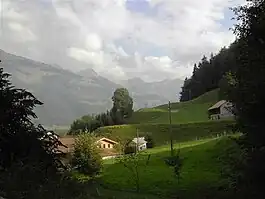 Landscape at Bas-Intyamon | |
 Coat of arms | |
Location of Bas-Intyamon | |
 Bas-Intyamon 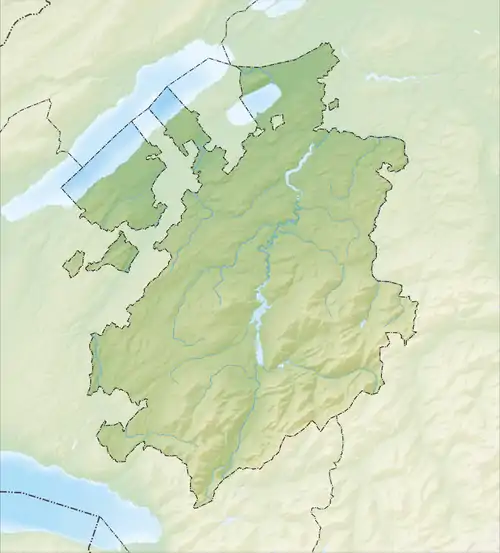 Bas-Intyamon | |
| Coordinates: 46°34′N 7°5′E | |
| Country | Switzerland |
| Canton | Fribourg |
| District | Gruyère |
| Government | |
| • Mayor | Syndic Claudio Derada |
| Area | |
| • Total | 33.27 km2 (12.85 sq mi) |
| Elevation | 720 m (2,360 ft) |
| Population (31 December 2018)[2] | |
| • Total | 1,454 |
| • Density | 44/km2 (110/sq mi) |
| Time zone | UTC+01:00 (Central European Time) |
| • Summer (DST) | UTC+02:00 (Central European Summer Time) |
| Postal code(s) | 1665-1667 |
| SFOS number | 2162 |
| Surrounded by | Grandvillard, Gruyères, Haut-Intyamon, Val-de-Charmey |
| Website | www SFSO statistics |
Geography
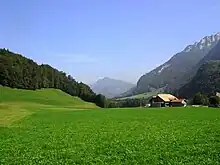
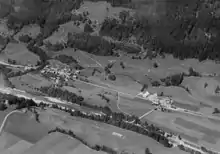
Bas-Intyamon has an area, as of 2009, of 33.3 square kilometers (12.9 sq mi). Of this area, 16.22 km2 (6.26 sq mi) or 48.7% is used for agricultural purposes, while 13.25 km2 (5.12 sq mi) or 39.8% is forested. Of the rest of the land, 0.92 km2 (0.36 sq mi) or 2.8% is settled (buildings or roads), 0.19 km2 (0.073 sq mi) or 0.6% is either rivers or lakes and 2.69 km2 (1.04 sq mi) or 8.1% is unproductive land.[4]
Of the built up area, housing and buildings made up 1.2% and transportation infrastructure made up 1.1%. Out of the forested land, 34.6% of the total land area is heavily forested and 3.6% is covered with orchards or small clusters of trees. Of the agricultural land, 0.5% is used for growing crops and 10.3% is pastures and 37.9% is used for alpine pastures. All the water in the municipality is flowing water. Of the unproductive areas, 4.7% is unproductive vegetation and 3.4% is too rocky for vegetation.[4]
Demographics
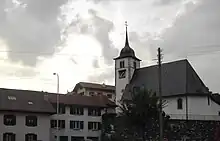
Bas-Intyamon has a population (as of December 2020) of 1,555.[5] As of 2008, 11.9% of the population are resident foreign nationals.[6] Over the last 10 years (2000–2010) the population has changed at a rate of 17%. Migration accounted for 18.2%, while births and deaths accounted for 2.4%.[7]
Most of the population (as of 2000) speaks French (95.3%) as their first language, German is the second most common (2.1%) and Albanian is the third (1.5%).[7]
As of 2008, the population was 48.6% male and 51.4% female. The population was made up of 463 Swiss men (42.2% of the population) and 70 (6.4%) non-Swiss men. There were 503 Swiss women (45.9%) and 60 (5.5%) non-Swiss women.[8]
As of 2000, children and teenagers (0–19 years old) make up 23.6% of the population, while adults (20–64 years old) make up 60.6% and seniors (over 64 years old) make up 15.9%.[7]
As of 2009, the construction rate of new housing units was 6.5 new units per 1000 residents.[7] The vacancy rate for the municipality, in 2010, was 2.2%.[7]
Sights
The entire villages of Estavannens and Villars-sous-Mont are designated as part of the Inventory of Swiss Heritage Sites.[9]

Politics
In the 2011 federal election the most popular party was the SP which received 30.7% of the vote. The next three most popular parties were the CVP (23.6%), the SVP (21.9%) and the FDP (11.1%).[10]
The SPS improved their position in Bas-Intyamon rising to first, from second in 2007 (with 22.4%) The CVP moved from first in 2007 (with 39.0%) to second in 2011, the SVP retained about the same popularity (18.2% in 2007) and the FDP retained about the same popularity (9.3% in 2007). A total of 375 votes were cast in this election, of which 8 or 2.1% were invalid.[11]
Economy
As of 2010, Bas-Intyamon had an unemployment rate of 2.9%. As of 2008, there were 45 people employed in the primary economic sector and about 17 businesses involved in this sector. 58 people were employed in the secondary sector and there were 5 businesses in this sector. 142 people were employed in the tertiary sector, with 24 businesses in this sector.[7] There were residents of the municipality who were employed in some capacity.
In 2008 the total number of full-time equivalent jobs was 197. The number of jobs in the primary sector was 36, of which 33 were in agriculture and 3 were in forestry or lumber production. The number of jobs in the secondary sector was 53 of which 41 or (77.4%) were in manufacturing, 11 or (20.8%) were in mining and 1 was in construction. The number of jobs in the tertiary sector was 108. In the tertiary sector; 33 or 30.6% were in wholesale or retail sales or the repair of motor vehicles, 1 was in the movement and storage of goods, 9 or 8.3% were in a hotel or restaurant, 2 or 1.9% were in the information industry, 2 or 1.9% were the insurance or financial industry, 1 was a technical professional or scientist, 4 or 3.7% were in education and 48 or 44.4% were in health care.[12]
Of the working population, 5.4% used public transportation to get to work, and 72.7% used a private car.[7]
Education
The Canton of Fribourg school system provides one year of non-obligatory Kindergarten, followed by six years of Primary school. This is followed by three years of obligatory lower Secondary school where the students are separated according to ability and aptitude. Following the lower Secondary students may attend a three or four year optional upper Secondary school. The upper Secondary school is divided into gymnasium (university preparatory) and vocational programs. After they finish the upper Secondary program, students may choose to attend a Tertiary school or continue their apprenticeship.[13]
During the 2010-11 school year, there were a total of 76 students attending 4 classes in Bas-Intyamon. A total of 174 students from the municipality attended any school, either in the municipality or outside of it. There were no kindergarten classes in the municipality, but 14 students attended kindergarten in a neighboring municipality. The municipality had 4 primary classes and 76 students. During the same year, there were no lower secondary classes in the municipality, but 36 students attended lower secondary school in a neighboring municipality. There were no upper Secondary classes or vocational classes, but there were 8 upper Secondary students and 46 upper Secondary vocational students who attended classes in another municipality. The municipality had no non-university Tertiary classes, but there were 2 specialized Tertiary students who attended classes in another municipality.[8]
References
- "Arealstatistik Standard - Gemeinden nach 4 Hauptbereichen". Federal Statistical Office. Retrieved 13 January 2019.
- "Ständige Wohnbevölkerung nach Staatsangehörigkeitskategorie Geschlecht und Gemeinde; Provisorische Jahresergebnisse; 2018". Federal Statistical Office. 9 April 2019. Retrieved 11 April 2019.
- Amtliches Gemeindeverzeichnis der Schweiz published by the Swiss Federal Statistical Office (in German) accessed 19 July 2011
- Swiss Federal Statistical Office-Land Use Statistics 2009 data (in German) accessed 25 March 2010
- "Ständige und nichtständige Wohnbevölkerung nach institutionellen Gliederungen, Geburtsort und Staatsangehörigkeit". bfs.admin.ch (in German). Swiss Federal Statistical Office - STAT-TAB. 31 December 2020. Retrieved 21 September 2021.
- Swiss Federal Statistical Office - Superweb database - Gemeinde Statistics 1981-2008 Archived June 28, 2010, at the Wayback Machine (in German) accessed 19 June 2010
- Swiss Federal Statistical Office Archived January 5, 2016, at the Wayback Machine accessed 17-November-2011
- Canton of Fribourg Statistics (in German) accessed 3 November 2011
- "Kantonsliste A-Objekte". KGS Inventar (in German). Federal Office of Civil Protection. 2009. Archived from the original on 28 June 2010. Retrieved 25 April 2011.
- Canton of Fribourg National Council Election of 23 October 2011 Statistics Archived 5 April 2012 at the Wayback Machine (in German and French) accessed 3 November 2011
- Swiss Federal Statistical Office, Nationalratswahlen 2007: Stärke der Parteien und Wahlbeteiligung, nach Gemeinden/Bezirk/Canton Archived May 14, 2015, at the Wayback Machine (in German) accessed 28 May 2010
- Swiss Federal Statistical Office STAT-TAB Betriebszählung: Arbeitsstätten nach Gemeinde und NOGA 2008 (Abschnitte), Sektoren 1-3 Archived December 25, 2014, at the Wayback Machine (in German) accessed 28 January 2011
- Chart of the education system in Canton Fribourg (in German)